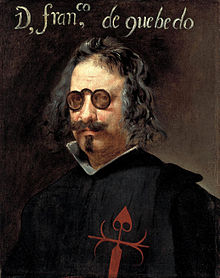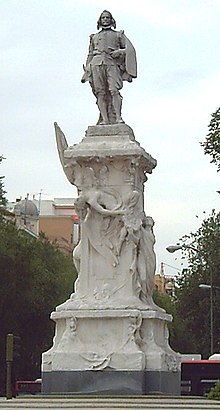Francisco de Quevedo


Francisco Gómez de Quevedo y Santibáñez Villegas (born September 14, 1580 in Madrid , † September 8, 1645 in Villanueva de los Infantes , province of Ciudad Real ) was a Spanish writer and satirist of the Baroque ( Spanish Siglo de Oro ). He was one of the masters of the so-called picaresque novel (span. Novela Picaresca ).
Life
Francisco Gómez de Quevedo y Santibáñez Villegas was baptized in Madrid on September 26, 1580, grew up in Madrid and studied ancient languages in Alcalá de Henares from 1596 to 1600 and theology at the University of Valladolid from 1601 to 1604 . He received a doctorate in theology, but was also active as a scientist and wrote satirical writings. He led a very unsteady life and was considered a womanizer. The first publication of poems took place in 1605 in the anthology "Flores de poetas ilustres" by Pedro Espinosa . From 1613 he was the private secretary of the Duke of Osuna in Sicily and Naples , where he was entrusted with important diplomatic missions. In 1632 he became Philip IV's secretary . Court intrigues put him in prison for several years (1639–43). Two years after his release, he died bitterly on his country estate.
He was enemies with the poet Luis de Góngora , whom he accused of being a converted Jew and homosexual. Against Góngora he also published the anti-Semitic diatribe Aguja de navegar cultos .
Quevedo limped and wore glasses, which is why glasses were previously called quevedos in Spanish . However, he was a good fencer who was immediately ready to duel for honor, literature, or politics.
Quevedo died in 1645 in a monastery in Villanueva de los Infantes; his remains were reburied several times. After all, it was no longer known where his grave was. In 2007, bone fragments were discovered in the crypt of a church in Villanueva de los Infantes, which researchers at the Complutense University of Madrid , including the forensic scientist José Antonio Sánchez, were able to attribute to Quevedo. The skull was missing, however, and so an irregularly shaped femur remained the main indication for the attribution of this grave.
plant
Quevedo was a master of conceptismo , the use of ambiguity to show intelligence. He became known through satirical writings, which he had written around 1606, but only published in 1627 under the title Sueños (Dreams, Poems) in Saragossa . His rich life experiences led Quevedo to mainly write satires. He also wrote poems and some religious and erotic stories. Quevedo was one of the most famous writers in Madrid at the beginning of the 17th century.
Quevedo's work is filled with “skepticism against collective power”; it seeks to offer “a society that is still predominantly concerned with its long-crumbling imperial program, an alternative based on the individual”. This alternative grows out of disillusionment, even disappointment: "History consists in the fact that people build their new things out of the ruins of the old and thus only deliver the material to further destruction".
Spanish
- Flores de poetas ilustres . 1605
- España defendida y los tiempos de ahora . 1609 (published 1916)
- Epitome a la historia de la vida exemplar y gloriosa muerte del bienaventurado F. Thomas de Villanueva . 1620
- Cartas del caballero de la Tenaza . 1621
- Grandes anales de quinze días . 1621
- La Política de Dios, govierno de Cristo y tiranía de Satanás . 2 parts, 1626–1655 (JO Crosby, Urbana / Ill. 1967)
- Historia de la vida del Buscón or Historia del gran Tacaño . 1626 (A. Castro 1926; F. Lázaro Carreter 1965; German 1665, 1826, 1904, 1913, 1963) - the main work of the Spanish picaresque novel, next to Lazarillo de Tormes and Guzmán de Alfarache .
- Sueños y discursos de verdades . 1606 (published: 1627; German: 1660–43, 1919, 1925 and 1966): 6 dream images in dialogue form
- La culta latiniparla . 1629
- The aguja de navegar cultos con la receta para hacer Soledades en un día . 1631
- Dotrina moral del conocimiento propio, y del desengaño de las cosas ajenas . 1630
- La cuna y la sepultura . 1635 (L. López Grigera, 1969; Celsa Carmen García Valdés, 2008)
- De los remedios de cualquier fortuna . 1638
- Providencia de Dios . 1641 (published 1700)
- La vida de Marco Bruto . 1632-1644
- Vida de San Pablo . 1644
- El parnaso español, monte en dos cumbres dividido . 1648 posthumously
- Las cuatro pestes del mundo y los cuatro fantasmas de la vida . 1651 posthumously
- Las tres musas últimas castellanas . 1670 posthumously
- La Fortuna con seso y la hora de todos . 1699 posthumously
- La constancia y paciencia del santo job . 1713 posthumously
German
- The adventurous life of the Buscón . translated by John Mich. Moscherosch 1671.
- Life of Don Pablos, country rascal, arch-rascals and main vagabonds . Translated from Spanish and provided with an afterword by Wilhelm Muster. Stuttgart: Cotta, 1984. ISBN 3-7681-9961-4 .
- The adventurous Buscón or the life and deeds of the well-known soldier Don Pablos from Segovia: an entertaining story. First in Spanish described by Francisco de Quevedo y Villegas. But here translated into High German by a lover and with illustrations based on charcoal drawings by Christoph Krämer. [Translator: HC Artmann]. Frankfurt am Main: Insel, 1980 (Insel-Taschenbuch; 459), ISBN 3-458-32159-4 .
- Life of the arch crook Pablos from Segovia . Translated from Spanish and with an afterword by Herbert Koch. 3rd edition Leipzig: Dieterich, 1980 ( Dieterich Collection ; Vol. 178)
- The dreams. Fortuna with a brain or everyone's hour . With a foreword by Jorge Luis Borges. Edited and translated by Wilhelm Muster. 2nd edition Frankfurt am Main: Insel-Verlag, 1980, ISBN 3-458-05297-6 .
- From the tower. Moral and erotic poems, satires and grotesques; Spanish - German . translated by Werner von Koppenfels. Mainz: Dieterich, 2003, ISBN 3-87162-058-0 .
- Poems , translated by Wilhelm Muster. Munich: Deutscher Taschenbuch-Verlag, 1986, ISBN 3-7681-9962-2 .
- Ass-Eyes joys and sorrows [1628]. Translated from the Spanish by Jürgen Buchmann, Leipzig 2011.
reception
Quevedo is one of the historical figures who play a role in the novels about the Spanish mercenary Alatriste by Arturo Pérez-Reverte . The portrayal of his personality in the novels corresponds very closely to reality.
Jorge Luis Borges wrote in a preface to one of his selections from the work that Quevedo was above all a "man of letters for men of letters"; but he also repeatedly referred to him (like Leopoldo Lugones ) as one of the (or even DEN) most excellent prose stylists in the Spanish language. According to Borges, the only reason why Quevedo never found its way into the canon of world literature is the fact that his works have not shaped a symbol that could permanently seize people's imaginations. In terms of his skills, Quevedo is not inferior to any of the great writers.
The Quevedo metro station in Madrid is named after him.
Individual evidence
- ↑ Date of birth according to Escritor documenta el día de nacimiento de Quevedo y zanja incertidumbre ( Memento of October 4, 2009 in the Internet Archive )
- ^ The modern lexicon, Volume 15; Bertelsmann Lexikon-Verlag; Gütersloh 1977
- ↑ Article: "Quevedo Tomb Found", April 14, 2007
- ↑ Andreas Dorschel , 'Rule in Yourself', in: Süddeutsche Zeitung No. 32 (February 9, 2004), p. 14
- ↑ Andreas Dorschel , 'Rule in Yourself', in: Süddeutsche Zeitung No. 32 (February 9, 2004), p. 14
- ^ Jorge Luis Borges : Foreword essay Francisco de Quevedo - Prose and Poems in Personal Library . S. Fischer Verlag 1995
literature
- Otto von Leixner : History of foreign literatures. Part 2 . Leipzig: Verlag von Otto Spamer 1898
- Jorge Luis Borges : Foreword Essay Francisco de Quevedo - Prose and Poems in Personal Library . S. Fischer Verlag 1995 - ISBN 978-3596105946
- Jorge Luis Borges : Essay Quevedo in Inquisitions . S. Fischer Verlag 2007 - ISBN 978-3596105830
- Ursula Hennigfeld: The ruined body. Petrarkistic sonnets from a transcultural perspective . Würzburg: Königshausen & Neumann 2008 - ISBN 978-3-8260-3768-9
Web links
- Literature by and about Francisco de Quevedo in the catalog of the Ibero-American Institute in Berlin
- Literature by and about Francisco de Quevedo in the catalog of the German National Library
- Works by and about Francisco de Quevedo in the German Digital Library
- Works by Francisco de Quevedo in the Gutenberg-DE project
- Francisco de Quevedo in the Internet Archive
- Literature by and about Francisco de Quevedo in the catalog of the library of the Instituto Cervantes in Germany
- Publications by and about Francisco de Quevedo in VD 17 .
| personal data | |
|---|---|
| SURNAME | Quevedo, Francisco de |
| ALTERNATIVE NAMES | Gómez de Quevedo y Santibáñez Villegas, Francisco |
| BRIEF DESCRIPTION | Spanish writer |
| DATE OF BIRTH | September 14, 1580 |
| PLACE OF BIRTH | Madrid |
| DATE OF DEATH | September 8, 1645 |
| Place of death | Villanueva de los Infantes , Province of Ciudad Real |

